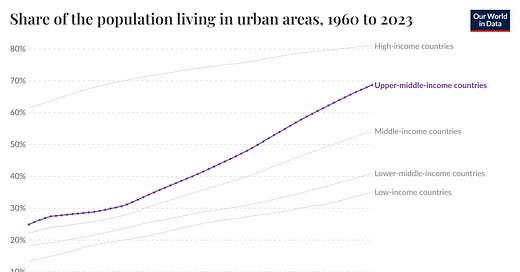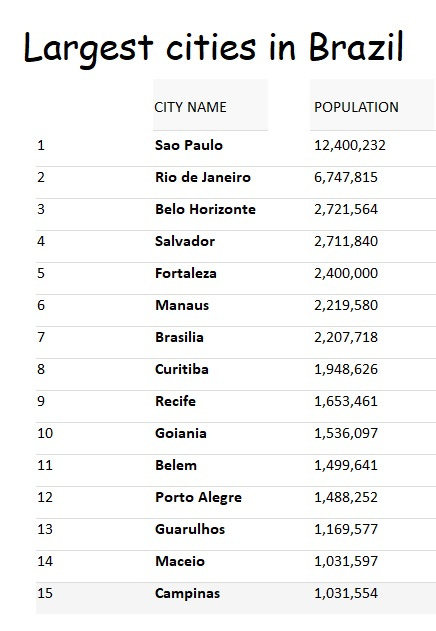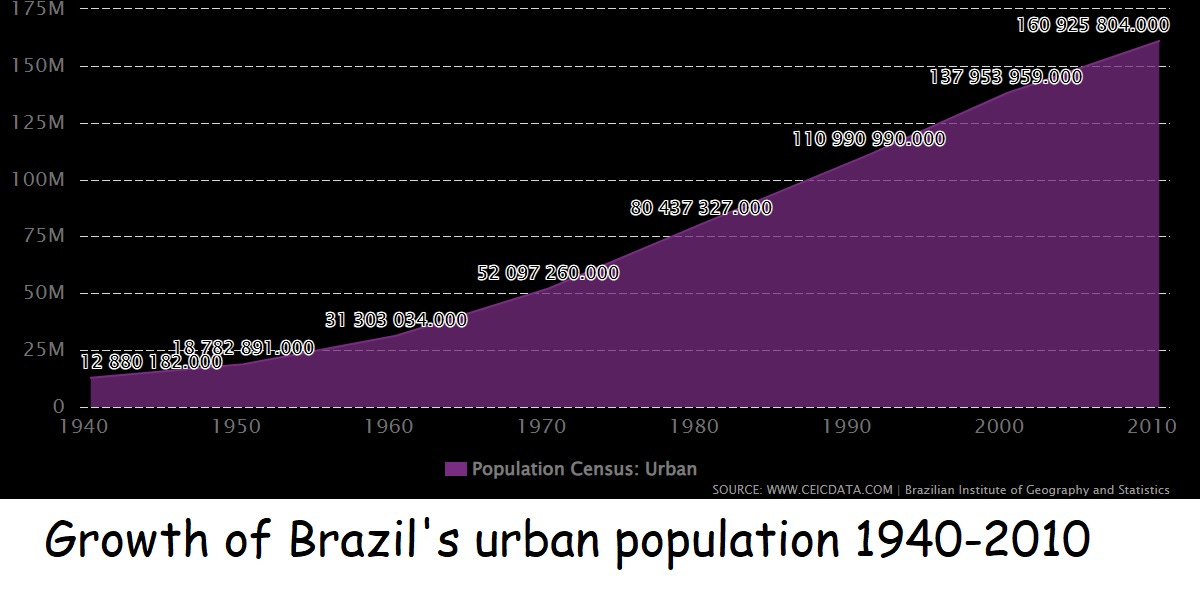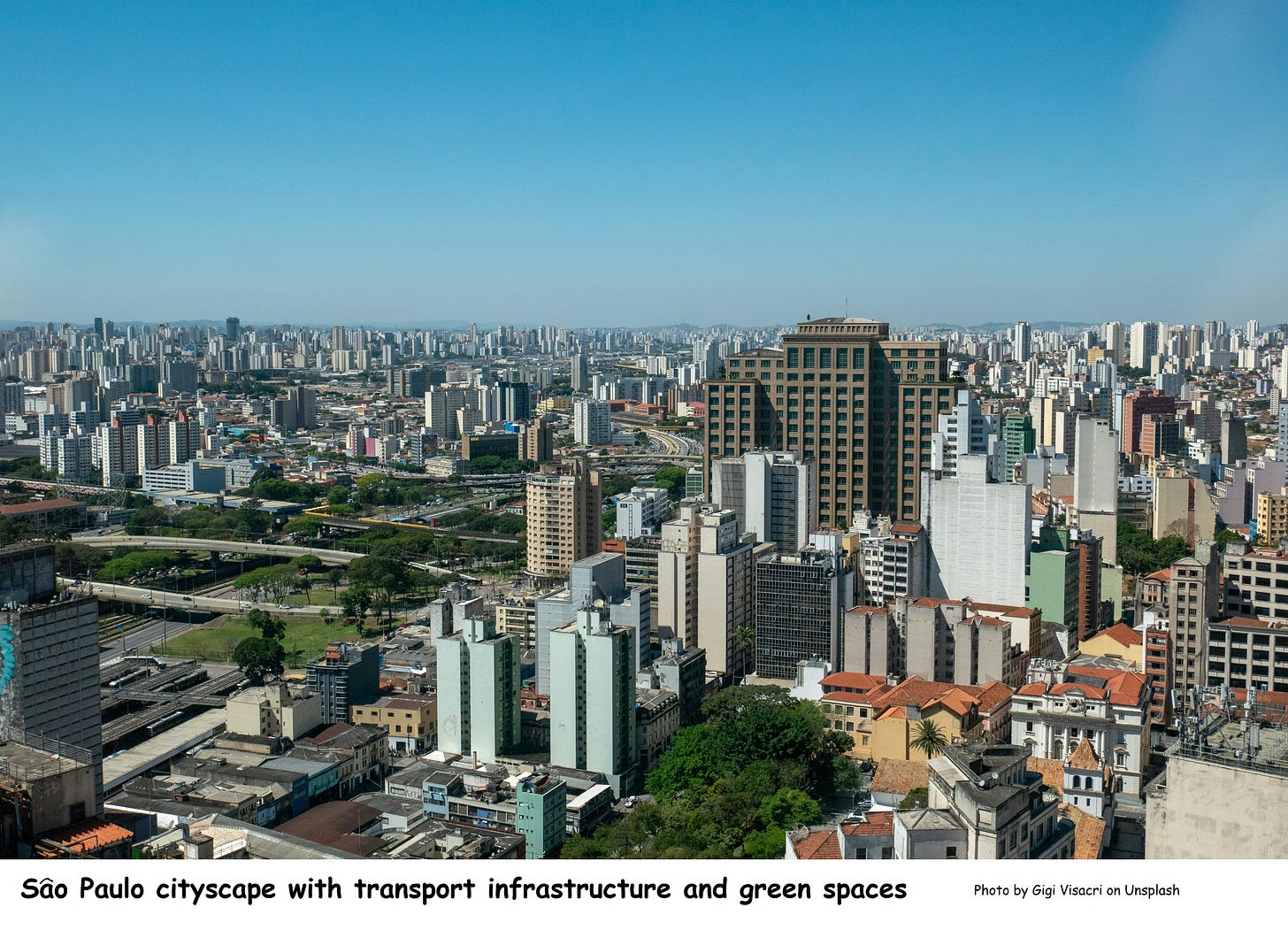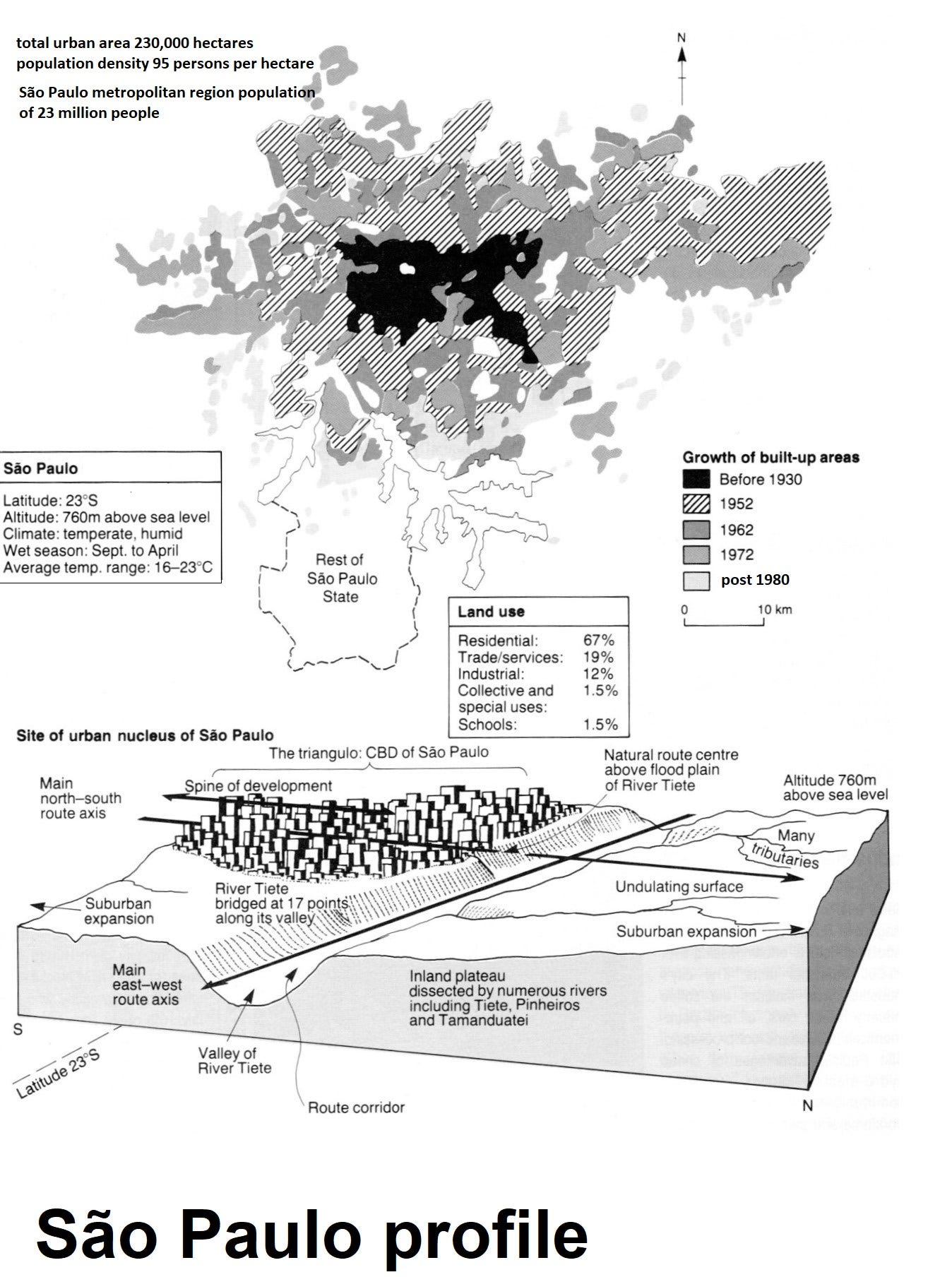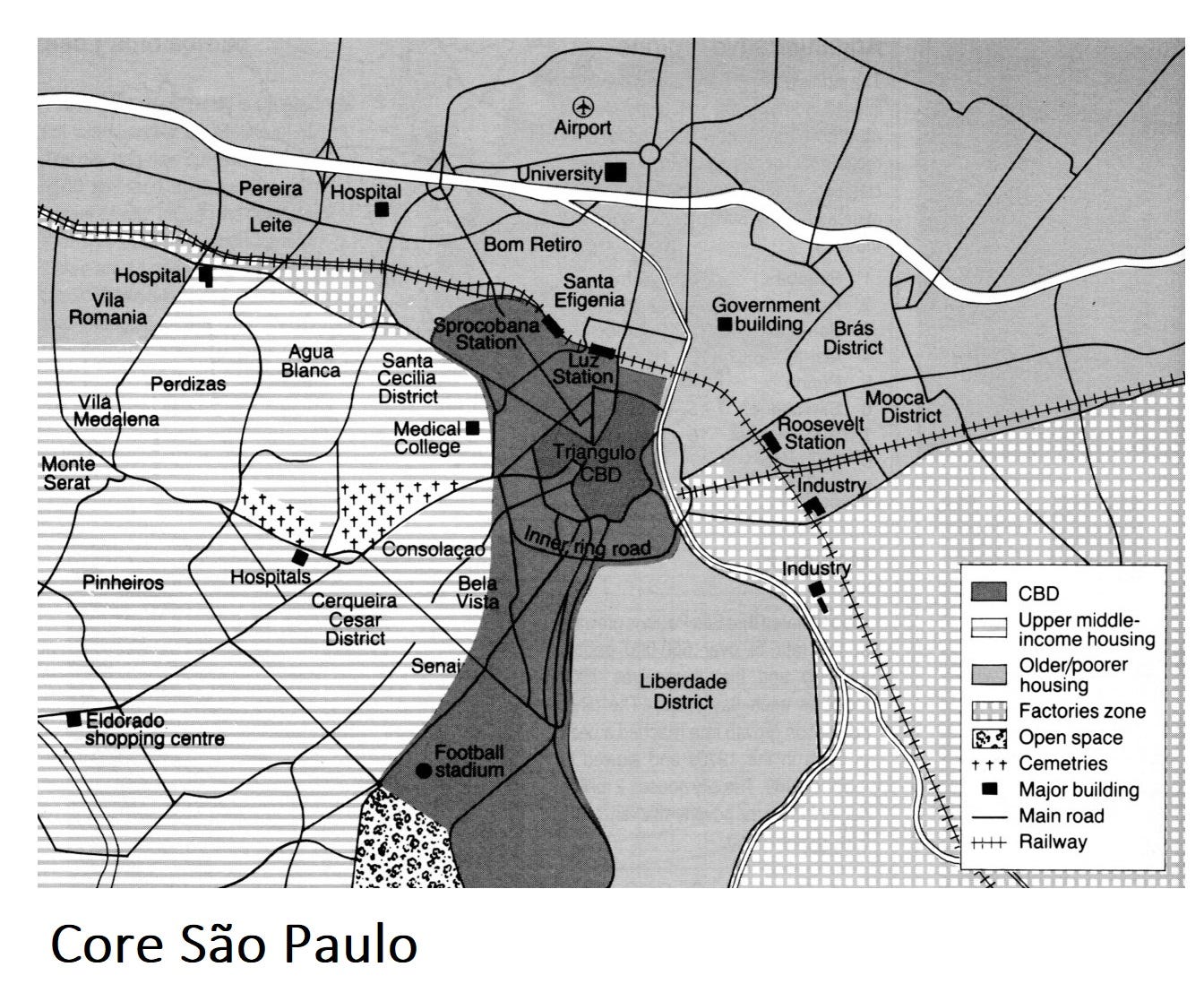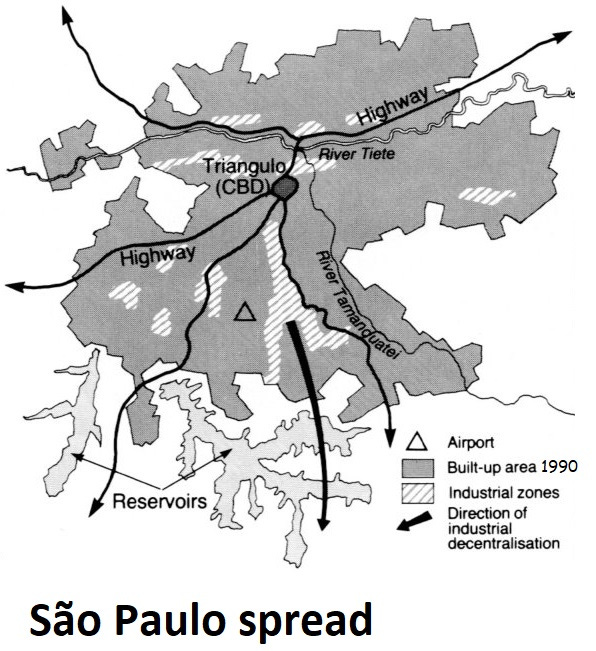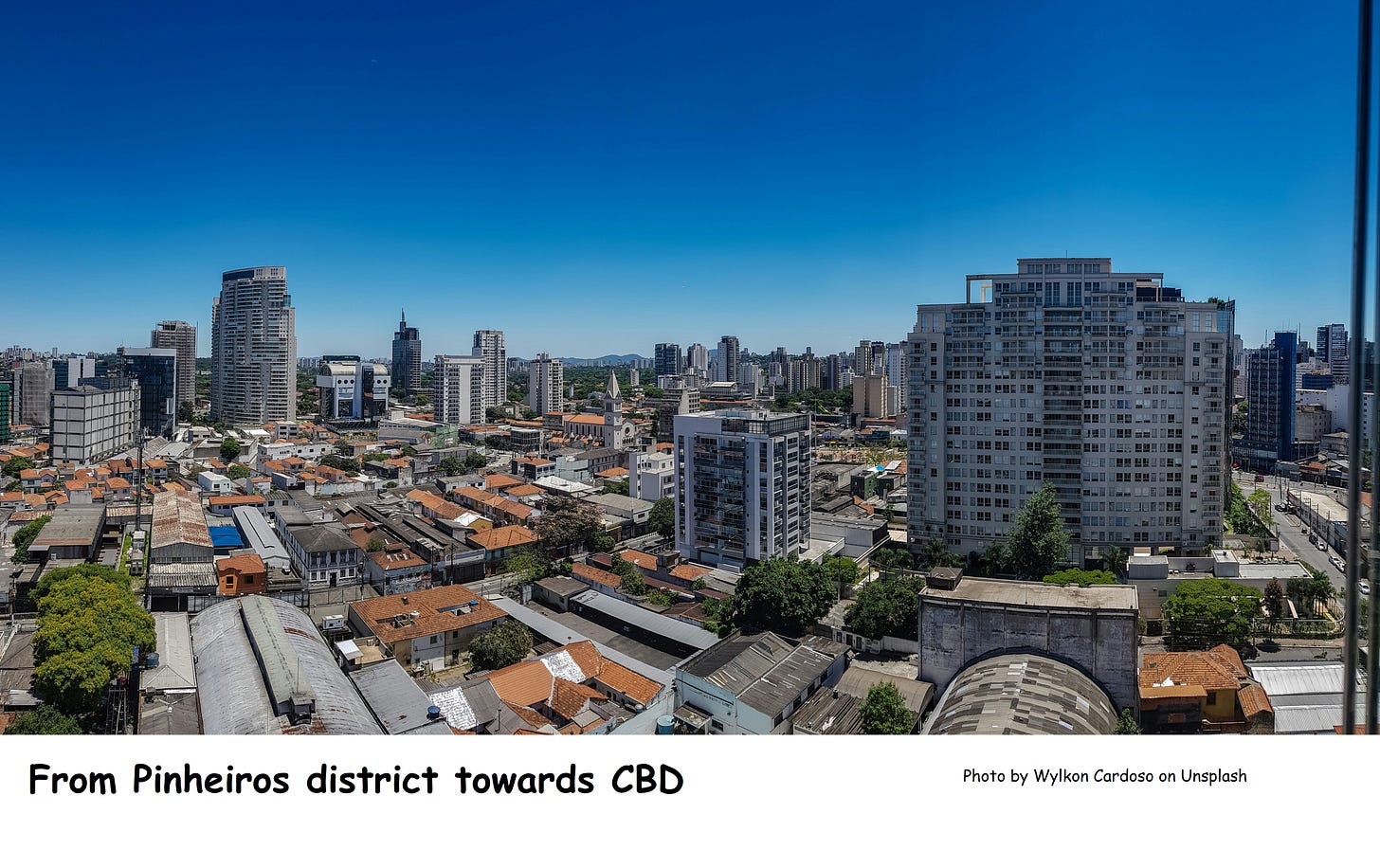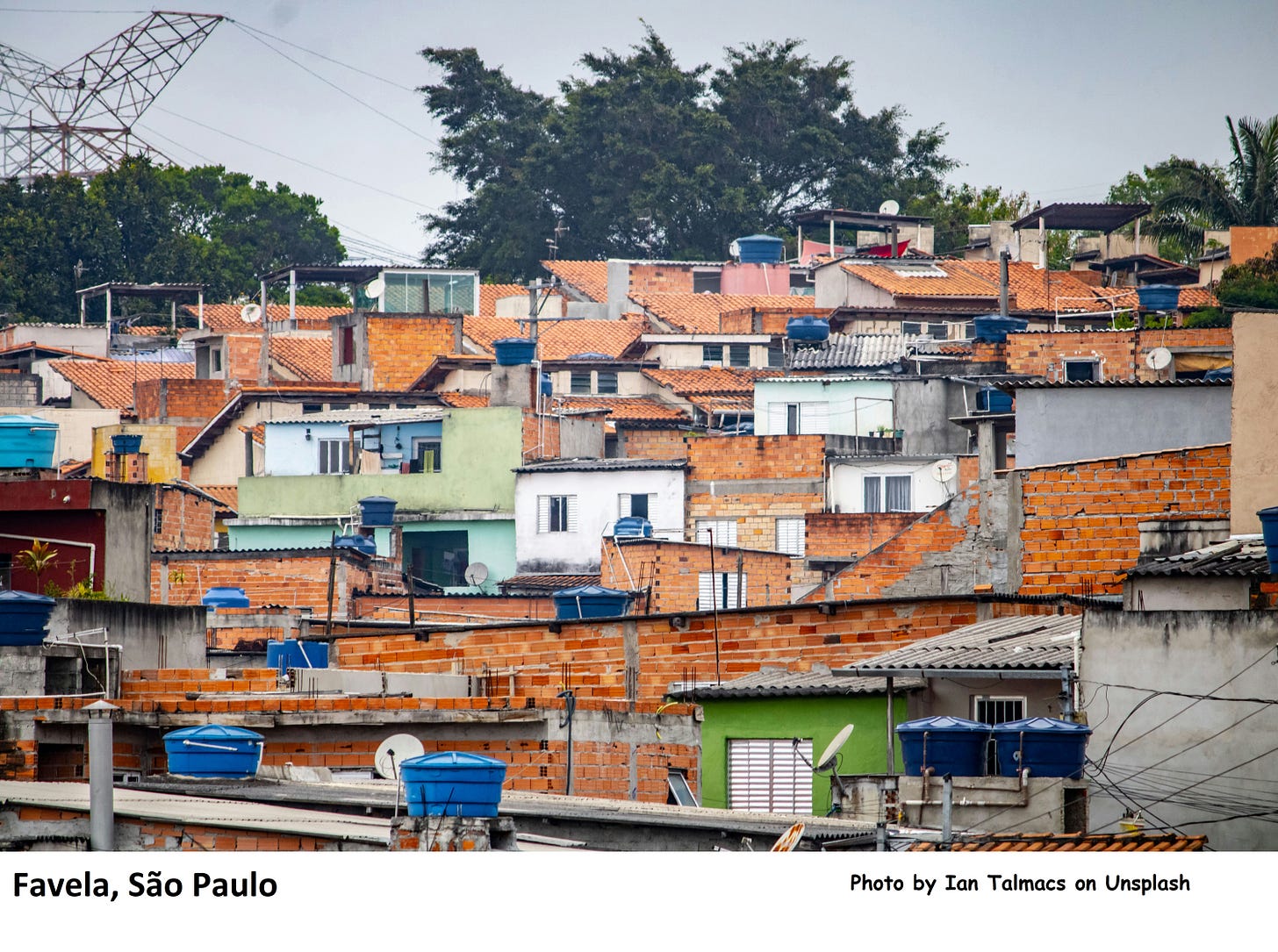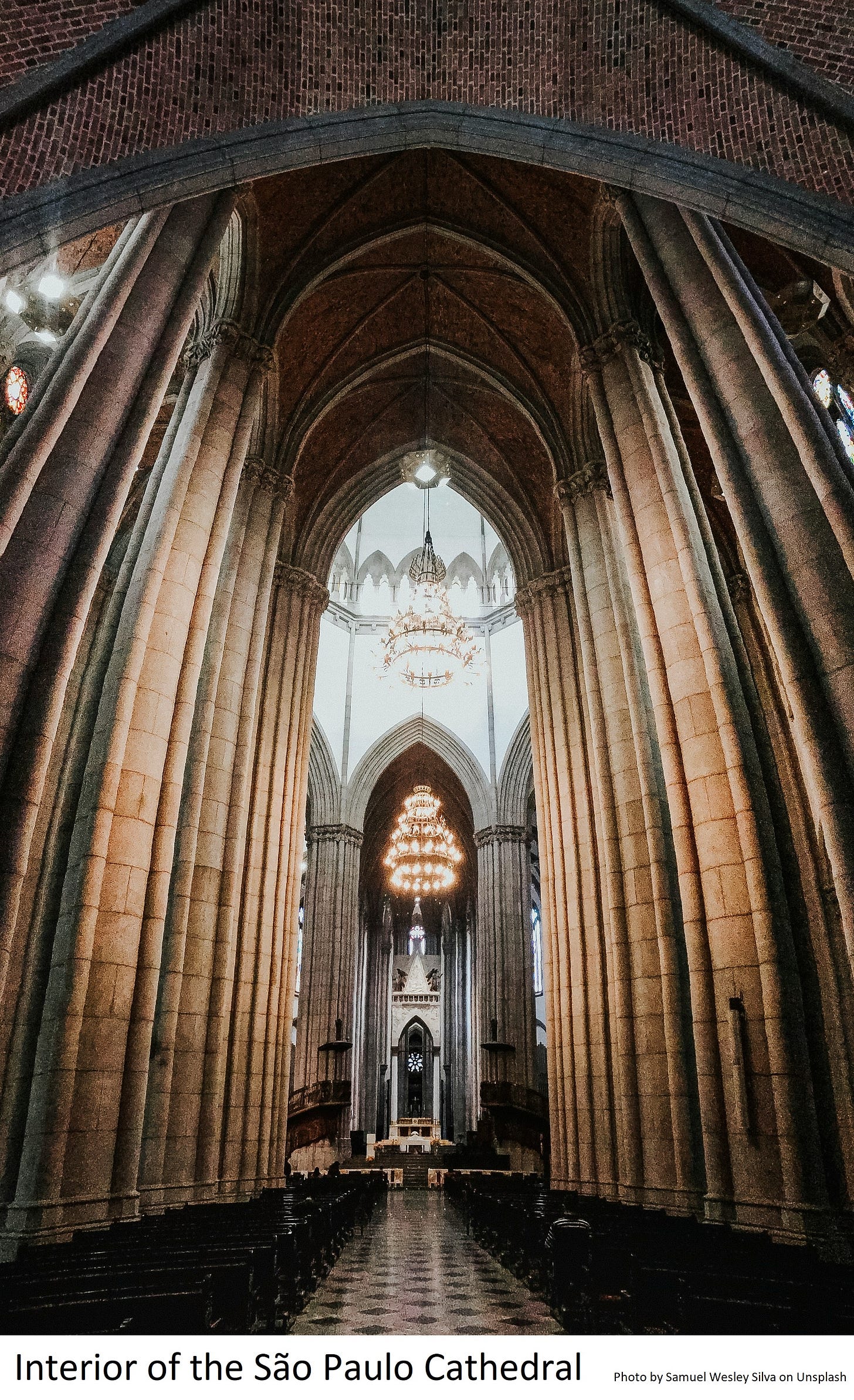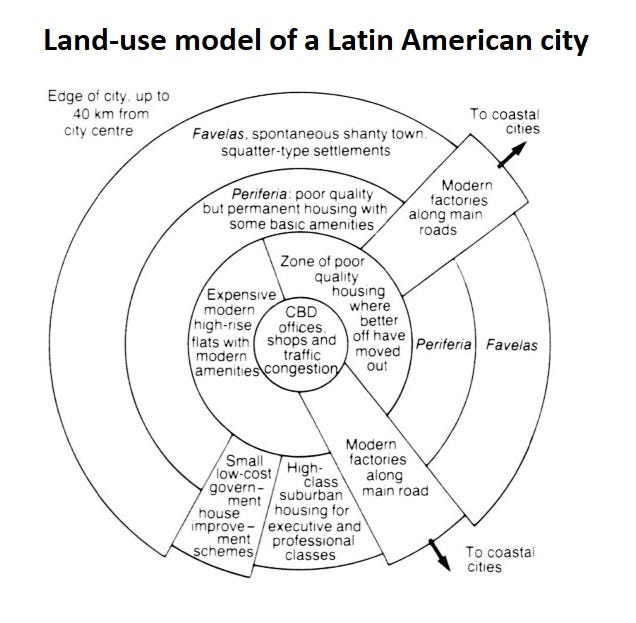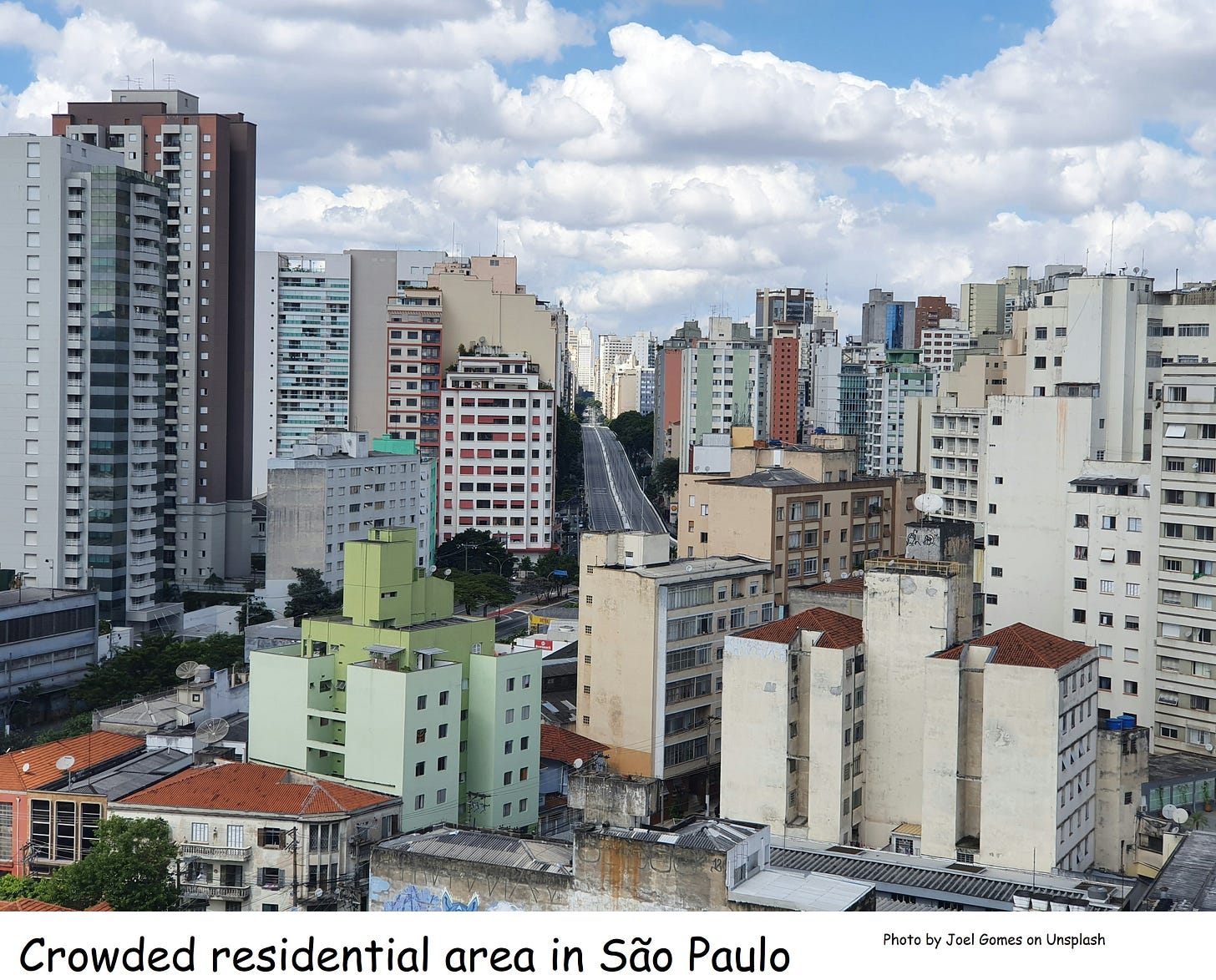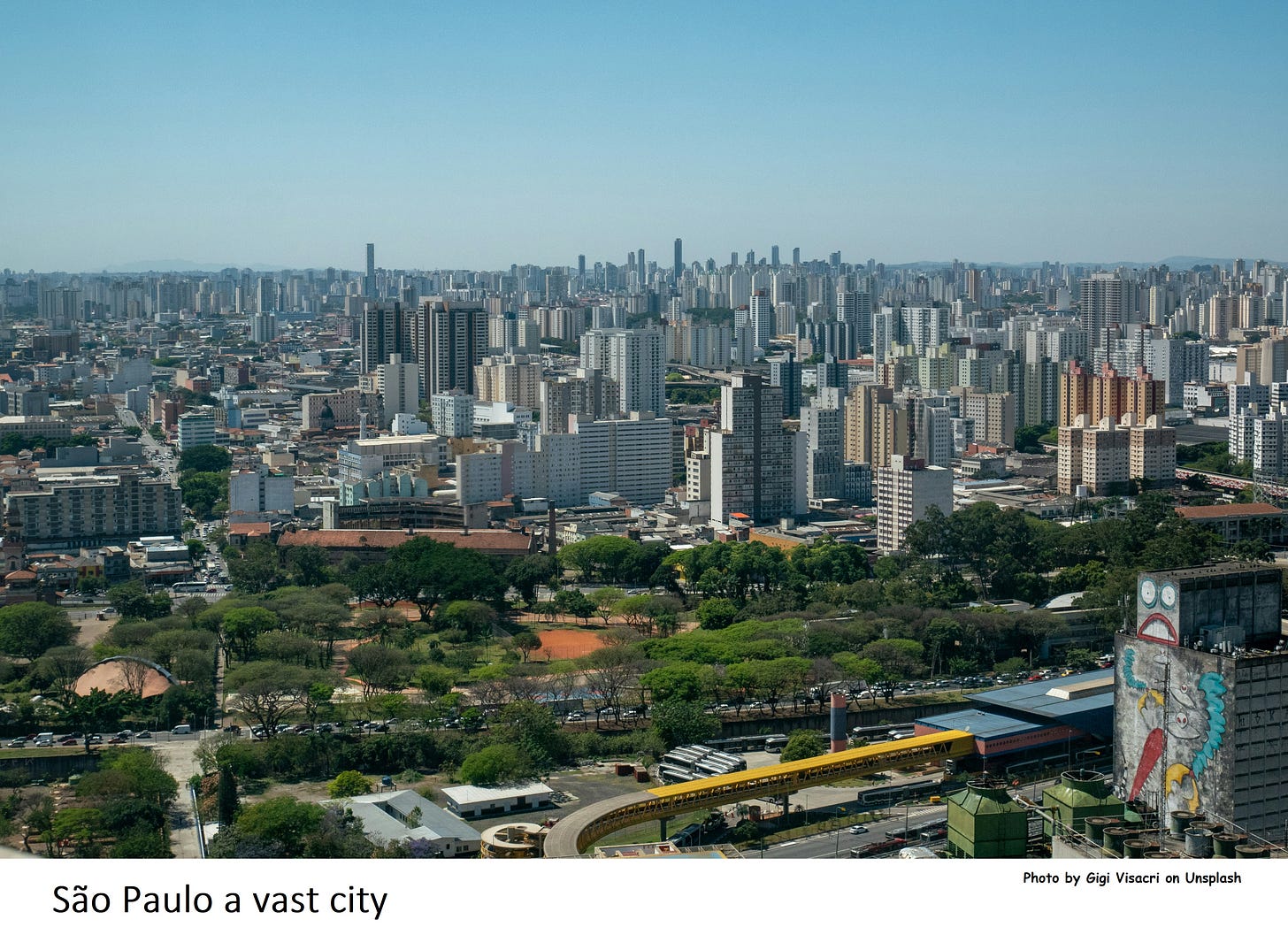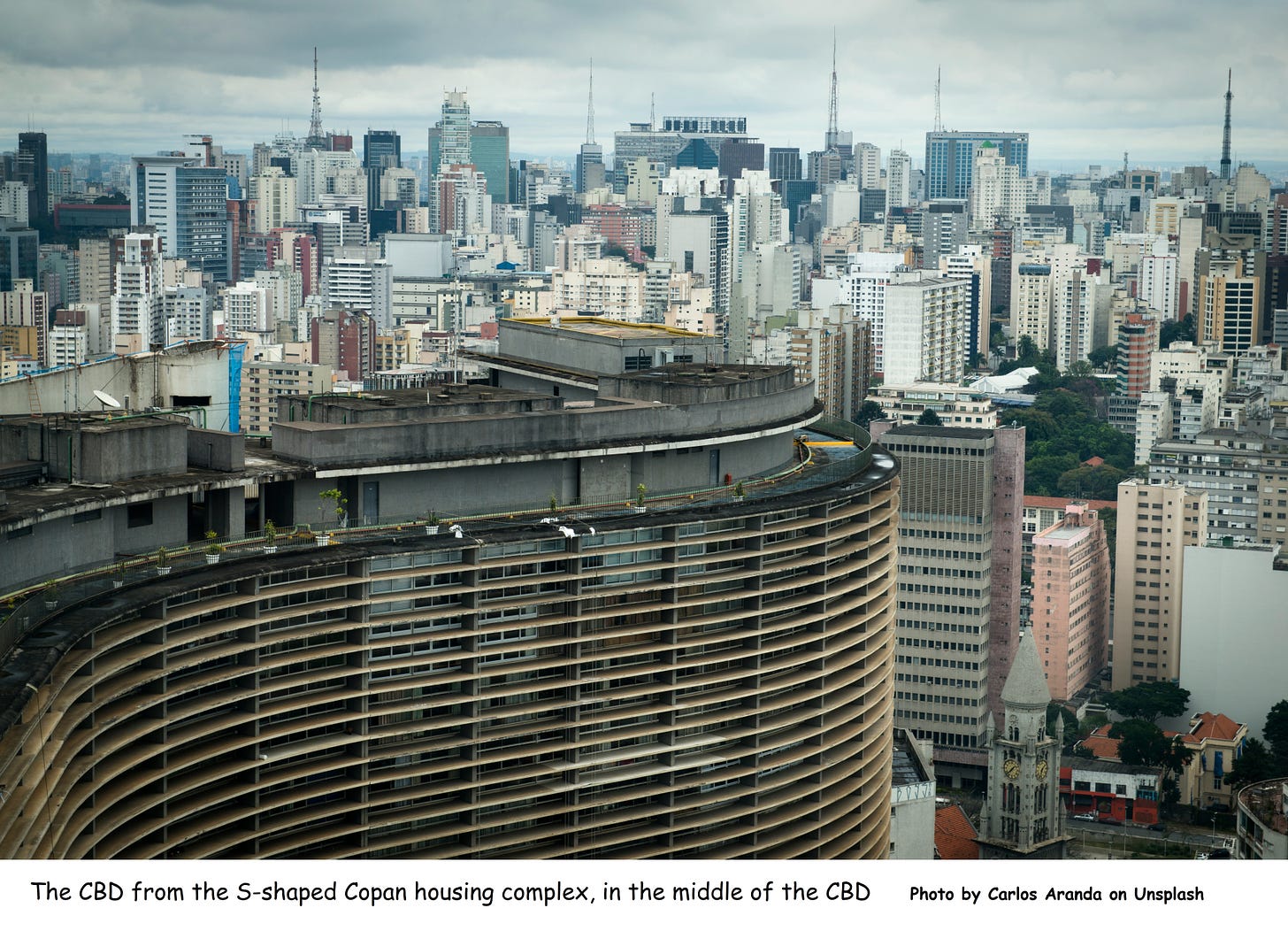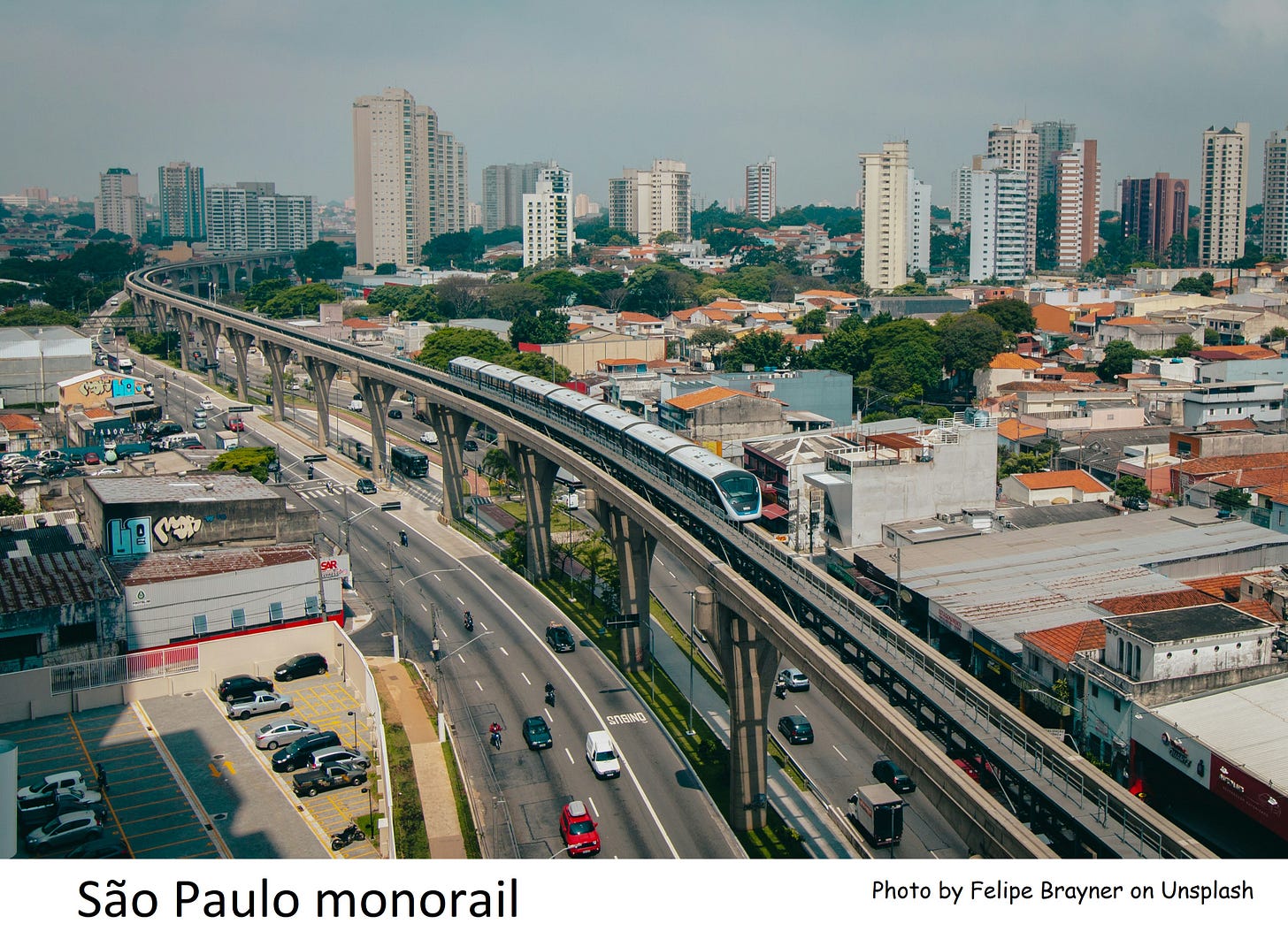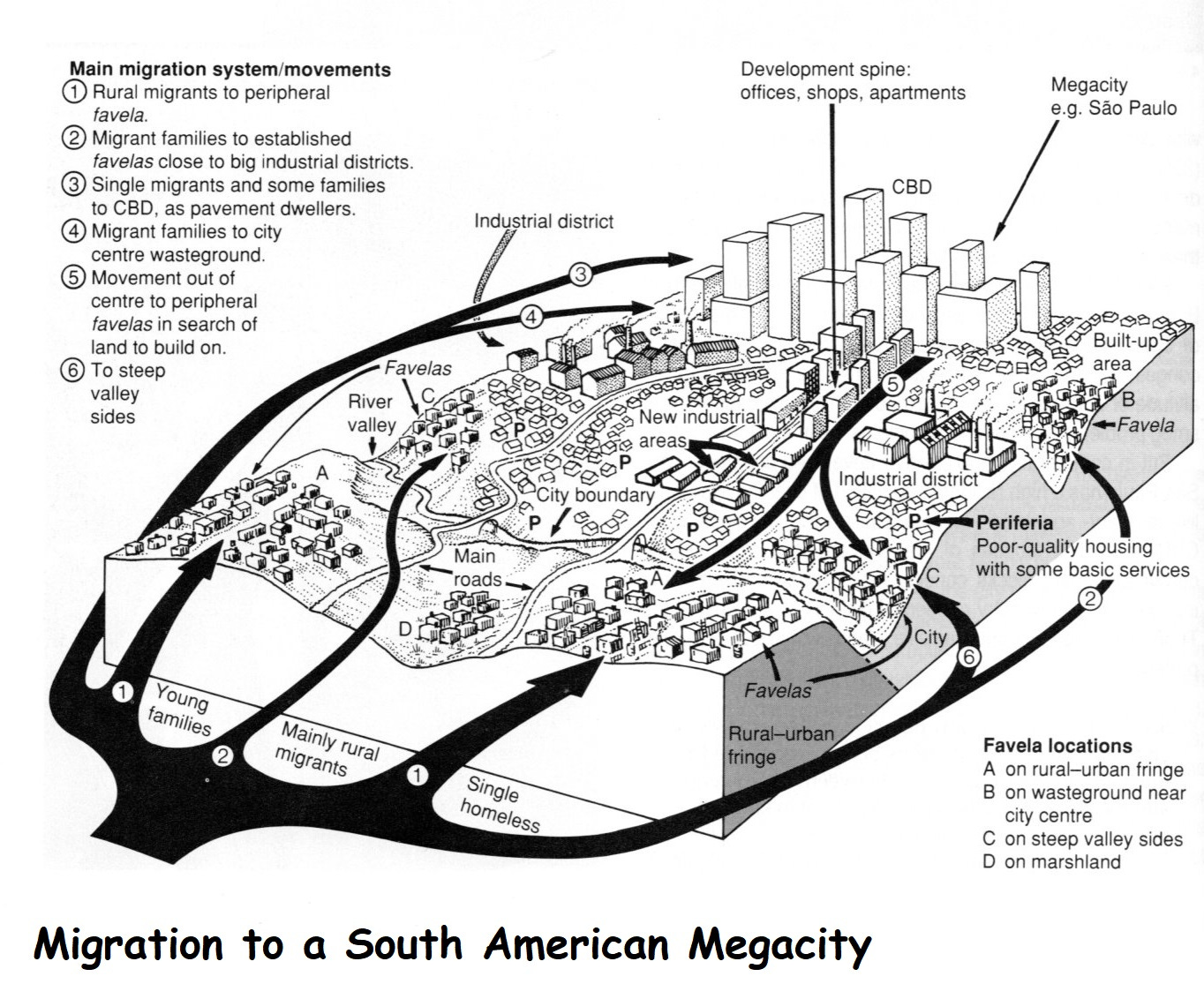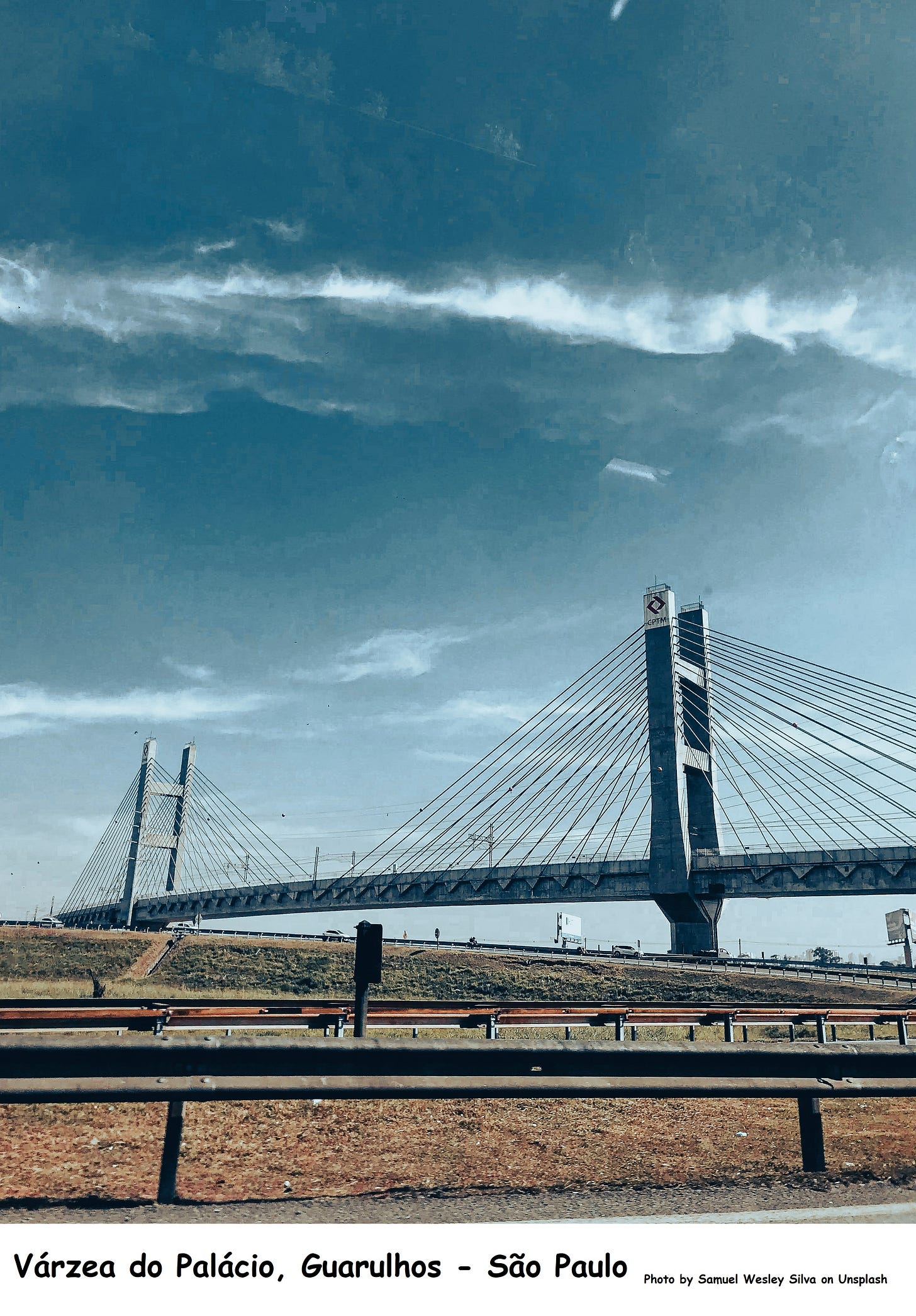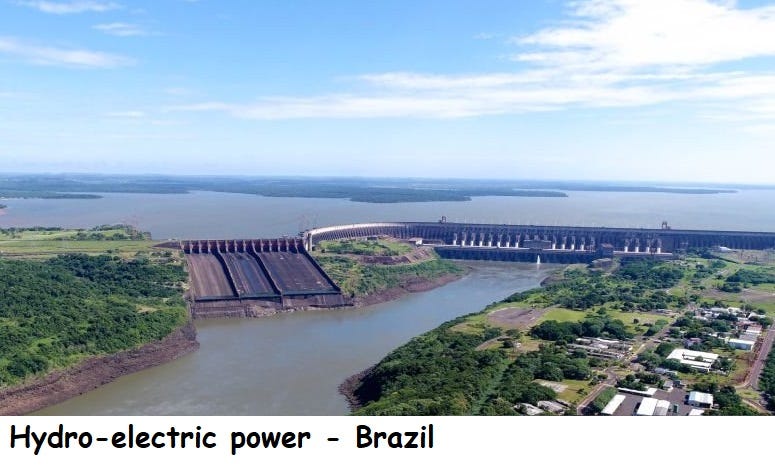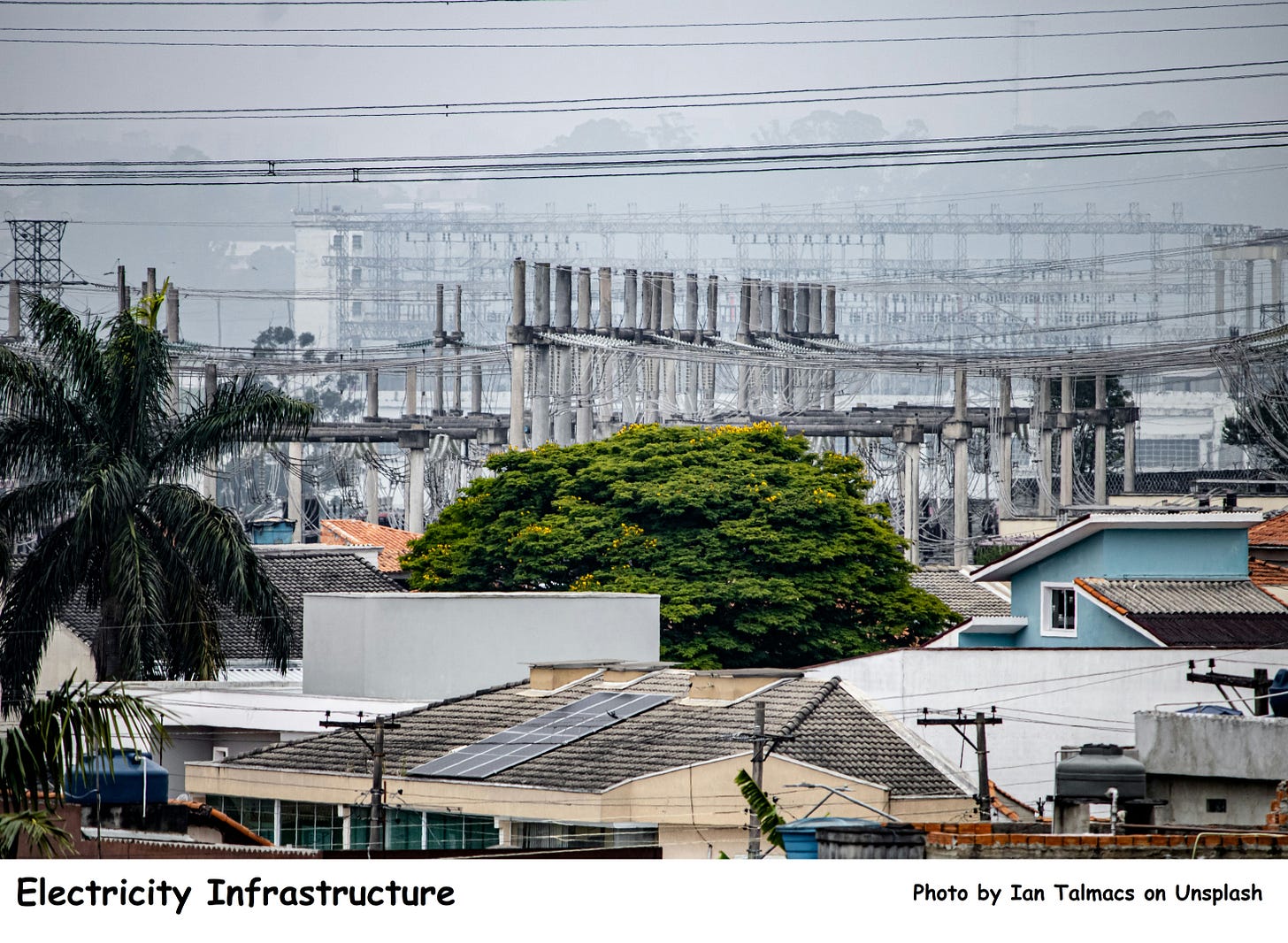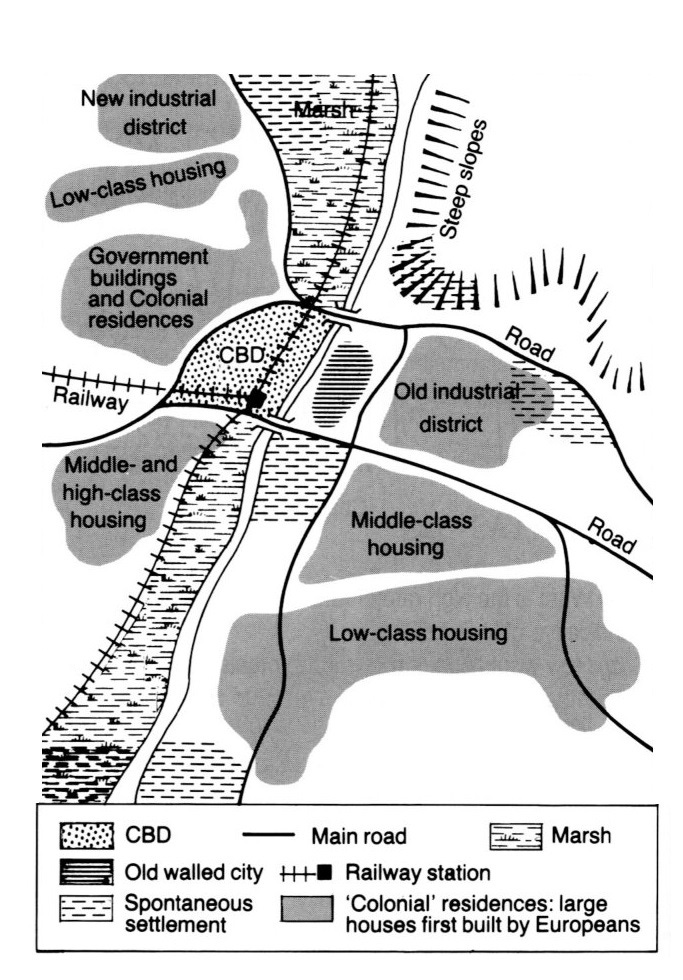(Please note this post is longer than normal and therefore email versions of the post may be truncated. You may need to view it on the Substack app or via this link on your computer. Geography Expert Substack | Ritchie Cunningham | Substack
The urbanisation of Brazil
The urbanisation of developing countries is an ongoing process, and although estimates vary it is commonly agreed around 58% of the population of developing countries are urban dwellers. Regardless of economic standing, all parts of the globe show a steady increase in urban dwelling.
Brazil is considered an Upper middle-income country where the urban population is now around 90% of the total population.
The urbanisation of Brazil has been a significant and ongoing process that has shaped the country's social, economic, and spatial landscapes. Brazil's urbanisation can be attributed to several factors, including rural-urban migration, industrialisation, and population growth.
The arrival of the Portuguese in 1500 began the colonial phase of settlement in what is now know as Brazil. The earliest European settlements were along the coast and major rivers. The bulk of the urban population are still found in these locations particularly in the south-east of the country. The most populous and urbanised area, is a triangle between Sao Paulo, Rio de Janeiro and Belo Horizonte (the “golden triangle”). Here settlements are growing so fast they are likely to merge into one another and produce a massive densely populated urban region.
The Brazilian government has been attempting to relieve population pressure on the coast by encouraging settlement of the interior, in ports along major rivers such as Manaus and the development of planned cities such as Brasilia (1960) and Goiânia (1937).
Population Growth: As of February 3, 2025, Brazil's population is estimated to be approximately 212.8 million people, based on recent projections and data. Over the past decade, Brazil's population growth rate has significantly slowed, reflecting broader demographic shifts:
Growth Rate significantly slowed: Between 2010 and 2022, Brazil's annual population growth averaged 0.52%.
Declining Yearly Growth: Between 2021 and 2025, the growth rates further decreased annually, from 0.46% in 2022 to 0.38% in 2025.
Fertility Rate Decline: The fertility rate dropped from 1.75 children per woman in 2010 to 1.57 in 2023, contributing to the slower growth.
Aging Population: The proportion of elderly individuals (60 years or older) nearly doubled from 8.7% in 2000 to 15.6% in 2023, while the average age of the population rose from 28.3 years in 2000 to 35.5 years in 2023
These trends indicate Brazil is undergoing a demographic transition, with declining birth rates and an ageing population playing key roles in slowing population growth. Brazil's population has experienced significant growth over the years, contributing to urbanisation.
High birth rates and declining mortality rates led to increased population density in urban areas. Large cities like São Paulo, Rio de Janeiro, and Salvador have seen substantial population growth, resulting in the expansion and densification of urban areas.
Rural-Urban Migration: One of the primary drivers of urbanisation in Brazil has been rural-urban migration. Starting in the mid-20th century, large numbers of people from rural areas began moving to cities in search of better economic opportunities and improved living conditions. Push factors such as poverty, land inequality, and limited access to basic services drove rural residents to seek a better life in urban centres.
Industrialisation and Economic Growth: Brazil's industrialisation process played a crucial role in urbanisation. The expansion of manufacturing sectors, particularly in cities like São Paulo and Rio de Janeiro, created employment opportunities and attracted rural migrants. Industrial growth led to the development of urban infrastructure, such as factories, transportation networks, and housing, further fuelling urbanisation.
Informal Settlements: As urbanisation progressed, informal settlements, known as favelas, emerged in many Brazilian cities. Favelas are characterised by informal housing, lack of basic services, and poor living conditions. These settlements developed as a result of inadequate housing options, limited access to land, and the inability of the formal housing sector to meet the housing needs of the growing population.
Growth in Brazil’s economy has lifted a number of people out of poverty and consequently, there are fewer people living in slum accommodation now than for decades. Indeed, the percentage of urban dwellers living in slums has fallen from 35% in 2000 to less than 15% in 2025.
Urban Infrastructure and Services: The rapid urbanisation of Brazil has posed challenges in terms of providing adequate infrastructure and services. As cities expanded, there was a need to invest in transportation networks, water supply, sanitation, healthcare, and education. The government has made efforts to improve infrastructure and expand services, but the demand often outpaces the available resources. In 1990 the urban population was 71% of total population by 2024 it had risen to 91% of total population.
Socioeconomic Inequalities: Urbanisation in Brazil has also highlighted socioeconomic inequalities. Many urban areas face issues of income disparity, unequal access to housing and services, and spatial segregation. The concentration of wealth and resources in certain urban centres has contributed to the marginalisation of low-income communities and the persistence of social inequalities.
Urban Planning and Policies: The Brazilian government has implemented urban planning strategies and policies to address the challenges of urbanisation. Initiatives have aimed to promote sustainable urban development, improve housing conditions, upgrade informal settlements, and enhance public transportation systems. The creation of urban development plans and the establishment of urban development agencies have been steps towards more coordinated and inclusive urban growth.
Environmental Concerns: The urbanisation of Brazil has raised environmental concerns, particularly in terms of deforestation, land degradation, and pollution. The expansion of cities has resulted in the loss of natural habitats, increased carbon emissions, and challenges in waste management. Environmental sustainability has become an important focus in urban planning and policy-making to mitigate these impacts.
The growth and development of São Paulo
São Paulo, often referred to as the economic and cultural hub of Brazil, has undergone significant growth and development over the years.
Early Settlement and Colonial Period: São Paulo was founded in 1554 by Jesuit missionaries and was initially a small settlement focused on agriculture. It grew slowly during the colonial period, with the cultivation of sugarcane and later coffee playing a significant role in the region's economic development. São Paulo residents, known as Paulistanos, are some of the most ethnically diverse in the country. At the end of slave trafficking in Brazil in 1850, the city replaced African labour with voluntary immigrants to work its coffee plantations. This brought in a wave of German, Portuguese and Swiss immigrants, followed by additional waves of Portuguese and Italian immigrants from the mid-19th century through the beginning of the 20th century.
Industrialisation and Immigration: The late 19th and early 20th centuries marked a period of rapid industrialisation in São Paulo. The city became a centre for textile manufacturing, coffee processing, and later, the automotive industry. This industrial growth attracted a massive influx of immigrants, primarily from Europe and Japan, who contributed to the city's cultural diversity and labour force.
Urban Expansion: São Paulo experienced substantial urban expansion throughout the 20th century. The city's population grew rapidly, and it became Brazil's largest city, driven by rural-urban migration and industrialisation. To accommodate the growing population, new neighbourhoods and residential areas were developed, resulting in the expansion of the urban fabric. From 1950 to 1975, São Paulo was one of the fastest-growing urban areas on earth. From 1980 to 2000, it also ranked 4th in population among the urban areas of the world, but it has since been displaced from this list by the unprecedented growth in areas like Delhi.
The largest city in South America is situated 100km inland and at an altitude of 850m, at the confluence of the Rivers Tiete and Tamanduatei. The city had spread to cover 1500 sq km by 1990 and has since swallowed up some smaller urban areas into Greater São Paulo. There are 11 main commuter corridors leasing to the CBD (The Triangulo) which is 8km in diameter.
There are around 12 million people living within the city limits. Greater São Paulo has many definitions, but the metropolitan region has 39 municipalities with a 2025 estimated population of 23 million people. This definition includes 38 smaller cities around São Paulo. Because the city has such a huge urban sprawl, there is another definition for its metropolitan area: Complexo Metropolitano Expandido, by this definition, greater São Paulo is the third largest city in the world with more than 27 million residents. The state of São Paulo has around 44 million inhabitants.
Infrastructure Development: São Paulo invested heavily in infrastructure to support its growth. The city developed an extensive transportation network, including roads, railways, and a subway system. The construction of major highways, such as Marginal Tietê and Marginal Pinheiros, facilitated commuting and improved connectivity. São Paulo is also home to Guarulhos International Airport, one of the busiest airports in Latin America.
Economic Powerhouse: São Paulo emerged as Brazil's economic powerhouse, driving the country's economy. It is a major centre for finance, commerce, and services. The city houses the headquarters of numerous national and multinational corporations, financial institutions, and stock exchanges. São Paulo's economic strength attracts professionals and entrepreneurs from across Brazil and the world.
Urban Challenges: The rapid growth and development of São Paulo have also presented challenges. The city faces issues such as traffic congestion, air pollution, inadequate public transportation, and social inequality. Favelas, or informal settlements, have developed on the outskirts of the city, housing a significant portion of the population in substandard conditions.
Cultural and Educational Hub: São Paulo is renowned for its vibrant cultural scene, including theatres, art galleries, museums, and music festivals. The city hosts prestigious educational institutions, including the University of São Paulo and the São Paulo State University, attracting students from across Brazil and beyond.
Urban Renewal and Modern Architecture: São Paulo has seen urban renewal projects and the development of modern architecture. The cityscape features an eclectic mix of architectural styles, ranging from colonial and neoclassical buildings to contemporary skyscrapers. Iconic structures like the São Paulo Cathedral, Copan Building, and Paulista Avenue exemplify the city's architectural diversity.
Green Spaces and Parks: Despite being a densely populated city, São Paulo has invested in creating green spaces and parks to enhance the quality of life for its residents. Notable examples include Ibirapuera Park, one of the largest urban parks in Latin America, and the Trianon Park, which offers a serene retreat amidst the bustling city.
Urban Planning Efforts: São Paulo has implemented urban planning initiatives to address its urban challenges. These efforts aim to improve public transportation, promote sustainable development, revitalise neighbourhoods, and enhance public spaces. Projects such as "Nova Luz" and the revitalisation of the São Paulo River are examples of urban planning endeavours to improve the city's liveability.
São Paulo has experienced remarkable growth and development, evolving from a small colonial settlement into a bustling metropolis and economic powerhouse.
City structure: São Paulo is the largest and wealthiest city in South America. Like most cities of the developing world São Paulo expanded rapidly and continues to expand despite a slowing in population growth. It is over twice the size and population of London and continues to expand as London experiences some counter-urbanisation. The rate of growth since 1930 and the scale of urbanisation has placed stresses on the city. The result is a very different city structure from that found in developed countries.
The contrast between rich and poor in São Paulo
São Paulo, like many other large cities around the world, exhibits significant contrasts between the rich and the poor. These contrasts are characterised by disparities in income, access to basic services, living conditions, and opportunities. Here are some key aspects that highlight the contrast between the rich and the poor in São Paulo:
Residential Segregation: São Paulo is marked by stark spatial segregation, with affluent neighbourhoods typically located in the city centre and upscale suburbs, while low-income communities are concentrated in peripheral areas or favelas. High-end residential areas, such as Jardins, Morumbi, and Higienópolis, boast luxurious mansions, gated communities, and high-rise condominiums, offering amenities and exclusivity. In contrast, favelas often lack proper infrastructure, basic services, and adequate housing conditions.
Housing Disparities: The housing conditions between the rich and the poor in São Paulo differ significantly. Affluent residents have access to spacious, well-maintained houses or apartments with modern amenities. These areas feature secure and well-patrolled neighbourhoods. In contrast, low-income residents, particularly those living in favelas, often face overcrowding, substandard housing, and limited access to essential services like clean water, sanitation, and electricity.
Access to Education: The quality of education also highlights the contrast between the rich and the poor in São Paulo. Wealthier families can afford to send their children to private schools that provide better resources, infrastructure, and educational opportunities. These schools often offer a higher standard of education and have access to extracurricular activities. In contrast, low-income families often rely on underfunded public schools, which may lack resources and struggle to provide quality education.
Healthcare Disparities: Access to healthcare services is another area of contrast. Wealthier residents can afford private healthcare, including top-notch hospitals, specialized clinics, and private healthcare insurance. They have greater access to medical specialists and advanced medical technologies. In contrast, lower-income residents often rely on public healthcare services, which may face challenges such as long wait times, overcrowding, and limited resources.
Employment and Income Disparities: São Paulo's economic inequality is evident in the disparities in employment opportunities and income levels. Affluent individuals often have access to high-paying jobs, positions in multinational corporations, and opportunities for career advancement. They enjoy the benefits of a thriving job market. In contrast, low-income individuals often face limited job prospects, informal employment, and lower wages. They may struggle to secure stable employment and often work in the informal sector, which lacks job security and social benefits.
Infrastructure and Public Services: Infrastructure and public services exhibit disparities between affluent and low-income areas. Wealthier neighbourhoods enjoy better infrastructure, including well-maintained roads, reliable public transportation, and access to recreational facilities. They also benefit from improved public services such as waste management and street cleaning. In contrast, low-income communities often experience inadequate infrastructure, unreliable public transportation, and insufficient access to essential services.
Social Exclusion and Opportunities: The contrast between the rich and the poor in São Paulo is further manifested in social exclusion and limited opportunities for upward mobility. Affluent individuals have greater access to networking opportunities, higher-quality education, and connections that can facilitate career advancement. They have more opportunities for cultural and recreational activities, which further contribute to social mobility. In contrast, low-income individuals often face social exclusion, limited access to resources, and barriers to advancement.
It is important to note that these contrasts are not absolute, and individuals and organisations are working towards reducing inequality and improving living conditions for marginalised communities. However, the contrast between the rich and the poor in São Paulo underscores the broader socioeconomic challenges faced by the city and the need for concerted efforts to address inequality and promote inclusive development.
The Central Business District of São Paulo
The Central Business District (CBD) of São Paulo, also known as the "Centro," or “Triangulo” is a bustling and vibrant area that serves as the commercial and financial heart of the city.
Location and Layout: The CBD is situated in the historic centre of São Paulo, spanning an area that covers several square kilometres. It is bordered by major avenues such as Avenida Ipiranga, Avenida São João, and Avenida Rangel Pestana. The CBD's layout is characterized by a grid-like street pattern, with busy thoroughfares intersecting at right angles, creating a sense of order and organisation.
Skyscrapers and Modern Architecture: The CBD of São Paulo is renowned for its impressive skyline, dominated by towering skyscrapers. These skyscrapers house the headquarters of national and international corporations, financial institutions, law firms, and other professional services. Prominent buildings in the CBD include the Edifício Itália, Altino Arantes Building (Banespa Building), and Edifício Copan. The architecture varies from sleek modern designs to historical buildings that showcase the city's architectural heritage.
Commercial Activities: The CBD is the epicentre of São Paulo's commercial activities. It is home to a wide range of businesses, including banks, stock exchanges, insurance companies, and corporate offices. Paulista Avenue, which extends from the CBD to the upscale neighbourhood of Jardins, is a major commercial thoroughfare lined with high-end shops, restaurants, and entertainment venues.
Financial Centre: São Paulo's CBD is the financial hub of Brazil. It houses the São Paulo Stock Exchange (B3), one of the largest stock exchanges in Latin America. Numerous national and international banks, including Banco do Brasil, Itaú Unibanco, and Santander, have their headquarters or major branches in the CBD. The concentration of financial institutions attracts professionals and facilitates business transactions and investment activities.
Transportation Hub: The CBD is well-connected to various transportation options, making it easily accessible. Several metro lines converge in the area, providing efficient transportation for commuters. Bus terminals and train stations are also located within the CBD, facilitating regional and intercity travel. The CBD's central location makes it a vital transportation hub, connecting different parts of the city and beyond.
Historic and Cultural Landmarks: The CBD of São Paulo features several significant historic and cultural landmarks. The São Paulo Cathedral (Catedral da Sé) is a notable religious site, known for its Gothic architectural style. The Pátio do Colégio, a historic building complex, marks the city's founding site and houses a museum that showcases São Paulo's history. The Teatro Municipal, a grand theatre built in the early 20th century, hosts operas, ballets, and other cultural performances.
Mixed Land Uses: While the CBD is primarily known for its commercial and financial activities, it also has a mix of other land uses. Alongside office buildings, you will find a variety of retail establishments, ranging from small shops to large department stores. The CBD also features restaurants, cafes, and entertainment venues, attracting both workers and visitors.
Urban Challenges: Despite its prominence, the CBD of São Paulo faces challenges common to many urban centres. Traffic congestion is a significant issue, particularly during peak hours. The high concentration of people and businesses puts pressure on infrastructure, including transportation networks and utilities. The CBD also experiences social inequalities, with a contrast between affluent business districts and nearby low-income neighbourhoods.
In summary, the Central Business District of São Paulo is a dynamic and bustling area that serves as the commercial and financial hub of the city. With its impressive skyline, modern architecture, and diverse range of businesses, the CBD showcases the prosperity of the city.
The development of favelas in São Paulo since 1960
The development of São Paulo's favelas since the 1960s reflects complex socio-economic dynamics. Rapid urbanisation and rural migration driven by industrialisation led to informal settlements as housing shortages and poor urban planning forced migrants into self-built communities. These areas, characterised by makeshift housing from recycled materials, faced marginalisation with limited access to water, sanitation, and land rights. Despite challenges, residents demonstrated resilience through grassroots initiatives, improving housing and infrastructure collaboratively. Government policies later focused on land regularisation and service upgrades, though gentrification and displacement emerged as new issues. Persistent problems include overcrowding, violence, and inequality, despite cultural vibrancy and informal economic activity.
Key Characteristics of Favelas:
Informal Housing: Self-built structures using materials like wood, metal, and brick, often non-compliant with building codes.
Density: Tightly packed homes with narrow alleyways due to land scarcity.
Infrastructure Gaps: Limited access to clean water, sanitation, electricity, and paved roads; frequent flooding.
Health risk from disease spread in tightly packed communities with limited sanitation.
Land Tenure Issues: Most lack property titles, hindering financial access and risking eviction.
Socio-Economic Challenges: High poverty, unemployment, crime, and limited education/healthcare access.
Community Resilience: Strong social networks, cultural expression (music, art), and informal economies (street vending, recycling).
Dynamic Evolution: Some areas upgrade gradually, while others face gentrification or redevelopment pressures.
These settlements remain a testament to both systemic neglect and the adaptability of marginalised communities.
Positive aspects of favelas-
· Homes for rural migrants
· Cheap homes for those on low incomes
· Easy to construct
· Large pool of labour for the city
· Community spirit
Negative aspects of favelas
· Built on illegal sites
· Unhealthy living conditions
· Unsafe houses
· Urban eyesores
· High unemployment
· Can be centres for crime and violence
· Centres of poverty
Urban planning in São Paulo since 1980
Urban planning in São Paulo since 1980 has been characterised by efforts to address the challenges posed by rapid urbanisation, population growth, and social inequality.
Master Plans and Zoning Regulations: São Paulo has implemented several master plans and zoning regulations to guide urban development. The Master Plan of 2002 was a significant milestone that aimed to establish guidelines for land use, infrastructure development, and public policies. Subsequent revisions and updates have focused on improving housing conditions, promoting sustainable development, and enhancing public spaces.
Urban Renewal Projects: São Paulo has undertaken urban renewal projects to revitalise and regenerate specific areas. The city has focused on transforming underutilised or deteriorating spaces into vibrant and functional urban areas. Examples include the transformation of the downtown area, known as "Centro Novo," and the revitalisation of the Pinheiros River waterfront, which has created new public spaces and improved connectivity.
Infrastructure Development: São Paulo has invested in infrastructure development to address transportation challenges and improve connectivity. This includes the expansion of the metro system, the construction of new bus corridors, and the implementation of cycling infrastructure. These initiatives aim to reduce traffic congestion, promote sustainable modes of transportation, and enhance accessibility across the city.
Housing and Social Programs: São Paulo has implemented various housing and social programs to address the housing deficit and improve living conditions for low-income residents. The city has focused on providing affordable housing options, upgrading informal settlements, and implementing slum eradication programs. The "Minha Casa, Minha Vida" (My House, My Life) program, a federal initiative, has also been implemented in São Paulo to provide subsidised housing for low-income families.
Public Space Improvement: São Paulo has prioritised the enhancement of public spaces to promote social interaction, recreation, and quality of life. This includes the creation of new parks, squares, and pedestrianized areas. Notable projects include the transformation of Minhocão, an elevated highway, into a linear park known as "Parque Minhocão," and the revitalisation of the Vale do Anhangabaú, a central public square.
Environmental Initiatives: São Paulo has implemented environmental initiatives to address sustainability and mitigate the effects of urbanisation. This includes promoting green spaces, tree planting campaigns, and initiatives to reduce air pollution and improve water management. The city has also implemented programs to encourage waste recycling and energy efficiency.
Participatory Planning and Citizen Engagement: São Paulo has sought to involve citizens and stakeholders in the planning process through participatory mechanisms. This includes public consultations, community engagement, and collaborative planning initiatives. The goal is to ensure that urban planning decisions reflect the needs and aspirations of the city's residents.
Despite these efforts, São Paulo still faces ongoing challenges in urban planning, including managing inequality, informal settlements, traffic congestion, and environmental sustainability. However, the city's urban planning initiatives since 1980 have sought to address these challenges and shape São Paulo into a more inclusive, sustainable, and liveable city.
Water Supply:
Water Shortages: São Paulo experienced a severe water crisis in 2014-2015, resulting from a combination of factors such as prolonged drought, increased demand due to population growth, and inadequate infrastructure. The Cantareira System, one of the city's main water reservoirs, reached critically low levels, leading to water rationing measures and widespread supply disruptions.
São Paulo's water supply infrastructure has faced challenges due to ageing and insufficient maintenance. Leaky pipes, outdated distribution networks, and inadequate storage capacity contribute to water loss and inefficiencies. The infrastructure's inability to cope with increased demand exacerbates the water supply issues.
Inequitable Distribution: The water supply problem in São Paulo is often characterised by inequitable distribution. Some areas, particularly wealthier neighbourhoods, may have more reliable and uninterrupted water supply, while lower-income areas, including favelas, experience more frequent shortages and inadequate access to clean water.
Water Pollution and Environmental Concerns: São Paulo's water bodies, such as rivers and reservoirs, face pollution challenges from industrial waste, untreated sewage, and urban runoff. This pollution affects water quality and poses risks to both human health and ecosystems.
Electricity Supply:
Insufficient Generation Capacity: São Paulo, as an industrial and populous city, demands a significant amount of electricity. Insufficient generation capacity can strain the electricity grid, leading to power outages and supply disruptions, particularly during periods of peak demand.
Dependence on Hydroelectric Power: Brazil relies heavily on hydroelectric power, with many of its power plants located in the Amazon Basin. Droughts, such as the one experienced in 2014-2015, can affect hydroelectric generation and subsequently impact the electricity supply in São Paulo.
Transmission and Distribution Challenges: The transmission and distribution infrastructure for electricity in São Paulo faces challenges related to aging infrastructure, limited capacity, and inadequate maintenance. These issues can lead to transmission losses, voltage fluctuations, and power outages.
Illegal Connections and Energy Theft: São Paulo, like many urban areas, faces challenges related to illegal connections and energy theft. Informal settlements and some neighbourhoods with socio-economic difficulties may resort to illegal connections to access electricity, leading to safety hazards, overloaded networks, and unreliable supply for legitimate customers.
Sustainability and Renewable Energy: São Paulo has been making efforts to diversify its energy sources and increase the share of renewable energy in its electricity mix. The promotion of solar power, wind energy, and other sustainable alternatives aims to enhance the resilience and sustainability of the electricity supply.
Addressing these water and electricity supply challenges requires investments in infrastructure development, improved maintenance practices, sustainable resource management, and equitable distribution strategies. The government, utility providers, and stakeholders continue to work on long-term solutions to ensure reliable and sustainable water and electricity supply for São Paulo's residents and businesses.
"Trickle-down" development refers to an economic theory and development approach that assumes the benefits of economic growth and prosperity will gradually trickle down from the wealthy or privileged segments of society to the less privileged or economically disadvantaged groups. In the case of Brazil, the country has implemented policies and development strategies that have relied, to some extent, on the concept of trickle-down economics.
Economic Growth and Wealth Concentration: Brazil has experienced periods of economic growth and expansion, particularly during the 2000s. However, the benefits of this growth have not always been evenly distributed across society. Instead, wealth concentration has occurred, with the affluent and powerful sectors of society benefiting the most.
Large-Scale Infrastructure Projects: Brazil has pursued large-scale infrastructure projects as a means of fostering economic growth. These projects often involve investments in sectors such as transportation, energy, and urban development. While these projects have the potential to stimulate economic activity and create jobs, the distribution of their benefits is not always equitable, and they tend to prioritise the interests of the wealthier segments of society.
Socioeconomic Disparities: Despite periods of economic growth, Brazil continues to grapple with significant socioeconomic disparities. The country has a high level of income inequality, with a considerable gap between the wealthy and the poor. Trickle-down development assumes that as the wealthy accumulate wealth, it will eventually benefit the less affluent, leading to poverty reduction and improved living standards. However, in Brazil, this process has been slow, and the benefits of economic growth have not reached all segments of society.
Limited Social Mobility: Trickle-down development relies on the notion that individuals can move up the socioeconomic ladder through economic growth opportunities. However, Brazil has faced challenges in promoting social mobility, as there are structural barriers that impede access to quality education, healthcare, and employment opportunities for the less privileged. This further hinders the effectiveness of trickle-down development in reducing poverty and inequality.
Poverty Alleviation Programs: To address social inequality and reduce poverty, Brazil has implemented various social programs, such as Bolsa Família, which provides conditional cash transfers to low-income families. These programs aim to provide a safety net for the most vulnerable populations and promote social inclusion. However, they can be seen as addressing the symptoms of inequality rather than addressing its underlying causes.
Changing Development Approaches: In recent years, Brazil has recognised the limitations of relying solely on trickle-down development and has started to shift towards more inclusive and participatory approaches. Efforts have been made to promote social policies that directly target poverty reduction, income redistribution, and the provision of basic services. The focus has shifted towards reducing inequality and improving social well-being as integral parts of sustainable development.
While Brazil has relied on trickle-down development to some extent, it has become increasingly aware of the need to address the underlying structural issues that perpetuate inequality. The country is gradually adopting a more balanced and inclusive approach that combines economic growth with targeted social policies to ensure that the benefits of development are shared more equitably among all segments of society.
Examination Questions on Urbanisation of Brazil and in particular São Paulo.
Multiple Choice Questions
What percentage of Brazil's population is estimated to be urban dwellers as of 2025?
A) 58%
B) 71%
C) 90%
D) 91%
Which area is referred to as the "golden triangle" of Brazil?
A) Brasília, Goiânia, Belo Horizonte
B) São Paulo, Rio de Janeiro, Belo Horizonte
C) Manaus, Salvador, Brasília
D) Rio de Janeiro, Salvador, Recife
What was a significant driver of rural-urban migration in Brazil?
A) Improved agricultural techniques
B) Better housing conditions in rural areas
C) Economic opportunities in urban areas
D) Government incentives for rural development
Which of the following is NOT a characteristic of favelas in Brazil?
A) Informal housing
B) High-quality infrastructure
C) High population density
D) Limited access to basic services
Short Answer Questions
Explain the impact of industrialisation on urbanisation in Brazil.
Discuss the socioeconomic inequalities present in São Paulo. Provide at least two examples.
What challenges does the Central Business District (CBD) of São Paulo face?
Identify and describe two urban planning initiatives implemented in São Paulo since 1980.
Study the map below and answer the following questions
a. Describe and account for the layout and land uses shown on this model of a city in the developing world.
b. To what extent is the model an accurate representation of the layout of any named city you have studied?
c. With the aid of a sketch population pyramid, describe the population structure of a city in the developing world, which has been affected by large-scale migration from its rural hinterland.
d. Referring to two named cities, one from the developing world and one from the developed world:
i) contrast their urbanisation processes
ii) compare their urban problems
iii) evaluate the effectiveness of the planning approaches adopted to deal with their respective problems.
Essay Questions
Analyse the demographic trends in Brazil from 2010 to 2025 and discuss their implications for urbanisation.
Evaluate the effectiveness of Brazil's government policies in addressing urbanisation challenges, particularly in relation to favelas and informal settlements.
Examination Questions on Urban Geography
What were the main factors driving urbanisation in the 20th century?
How did industrialisation contribute to the growth of urban areas?
What are some of the social changes that accompanied urbanisation in the 20th century?
How did technological advancements influence urbanisation in the 21st century?
What are some of the challenges posed by rapid urbanisation in developing countries?
How do the definitions of urban areas vary between different countries?
What are some of the environmental impacts of urbanisation?
How have cities addressed the negative consequences of urbanisation to create more sustainable environments?
FEEL FREE TO BUY ME A COFFEE IF YOU LIKE MY FREE RESOURCES
or one of my inexpensive books at
Amazon.co.uk: Ritchie Cunningham: books, biography, latest update


